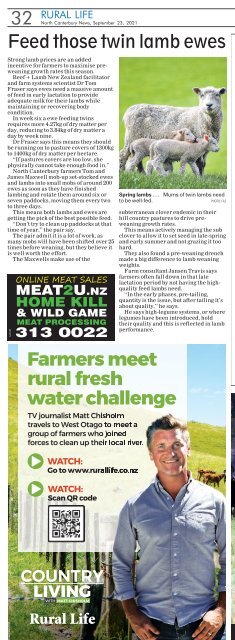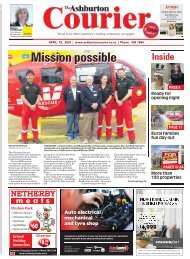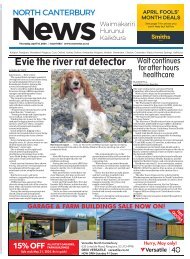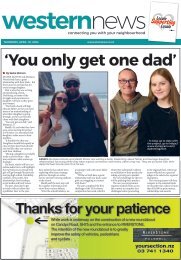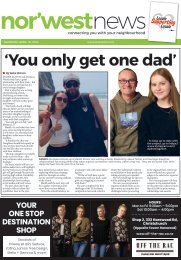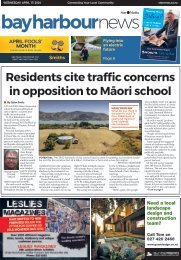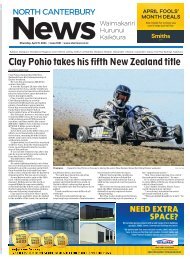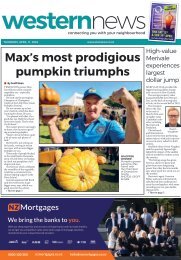North Canterbury News: September 23, 2021
Create successful ePaper yourself
Turn your PDF publications into a flip-book with our unique Google optimized e-Paper software.
RURAL LIFE<br />
32 <strong>North</strong> <strong>Canterbury</strong> <strong>News</strong>, <strong>September</strong> <strong>23</strong>, <strong>2021</strong><br />
Feed those twin lamb ewes<br />
Strong lamb prices are an added<br />
incentive for farmers to maximise preweaning<br />
growth rates this season.<br />
Beef +Lamb New Zealand facilitator<br />
and farm systems scientist Dr Tom<br />
Fraser says ewes need amassive amount<br />
of feed in early lactation to provide<br />
adequate milk for their lambs while<br />
maintaining or recovering body<br />
condition.<br />
In week six aewe feeding twins<br />
requires more 4.27kg of dry matter per<br />
day, reducing to 3.84kg of dry matter a<br />
day by week nine.<br />
Dr Fraser says this means they should<br />
be running on to pasture covers of 1300kg<br />
to 1400kg of dry matter per hectare.<br />
‘‘If pastures covers are too low, she<br />
physically cannot take enough food in.’’<br />
<strong>North</strong> <strong>Canterbury</strong> farmers Tom and<br />
James Maxwell mobup setstocked ewes<br />
and lambs into small mobs of around 200<br />
ewes as soon as they have finished<br />
lambing and rotate them around six or<br />
seven paddocks, moving them every two<br />
to three days.<br />
This means both lambs and ewes are<br />
getting the pick of the best possible feed.<br />
‘‘Don’t try to clean up paddocks at that<br />
time of year,’’ the pair say.<br />
The pair admit it is alot of work, as<br />
many mobs will have been shifted over 25<br />
times before weaning, but they believe it<br />
is well worth the effort.<br />
The Maxwells make use of the<br />
2410273<br />
ONLINE MEAT SALES<br />
MEAT2U.NZ<br />
HOME KILL<br />
&WILD GAME<br />
MEAT PROCESSING<br />
313 0022<br />
Spring lambs ... Mums of twin lambs need<br />
to be wellfed.<br />
PHOTO: FILE<br />
subterranean clover endemic in their<br />
hill country pastures to drive preweaning<br />
growth rates.<br />
This means actively managing the sub<br />
clover to allow it to set seed in latespring<br />
and early summer and not grazing it too<br />
hard.<br />
They also found apreweaning drench<br />
made abig difference to lamb weaning<br />
weights.<br />
Farm consultant Jansen Travis says<br />
farmers often fall down in that late<br />
lactation period by not having the highquality<br />
feed lambs need.<br />
‘‘In the early phases, pretailing,<br />
quantity is the issue, but after tailing it’s<br />
about quality,’’ he says.<br />
He says highlegume systems, or where<br />
legumes have been introduced, hold<br />
their quality and this is reflected in lamb<br />
performance.<br />
Country of origin ... NZPork wants country of origin labelling now.<br />
PHOTO:NZPORK<br />
Label delay frustrates<br />
New Zealand’s porksectoris<br />
disappointed ‘‘countryoforigin’’<br />
labellinghas been delayedagain.<br />
The Governmenthas announcedthe<br />
regulations covering fresh and chilled<br />
food,including pork and curedpork have<br />
been delayed for three monthsuntil<br />
February 2022.<br />
‘‘We wereeagerlyawaiting these<br />
regulations to come into force in<br />
November,’’ NZPork chief executive<br />
DavidBaines says.<br />
‘‘Without theseregulations, imported<br />
pork can be ‘hidden’ in ham and bacon<br />
processedinNew Zealand underalabel<br />
‘MadeinNew Zealand’.’’<br />
Research by NZPork indicates many<br />
consumers are surprised when they<br />
learnpork in these products may be<br />
imported fromanumber of countries.<br />
‘‘That’swhy thisthree month delayis<br />
hugely frustratingfor our New Zealand<br />
farmers when cheaper pork imports, that<br />
don’thavetomeetNew Zealand’s high<br />
welfare or environmental standards, can<br />
be presented to consumers without clear<br />
labelling,’’MrBainessays.<br />
‘‘While we appreciatethe delayisdue<br />
to the disruptionand uncertainty caused<br />
to business by thereemergenceof<br />
Covid19, we are particularly<br />
disappointed that the regulationswill<br />
notbeinplace for the Christmas period<br />
like we expected.<br />
‘‘Despite theregulatory delay, NZPork<br />
will still be encouraging consumers to<br />
look on the label and ask retailers for<br />
NewZealand born and raisedpork,<br />
especially goinginto theChristmas ham<br />
season.’’<br />
The regulations will enable consumers<br />
to be moreinformed as to where their<br />
food is being imported from and what<br />
pork is New Zealand born and raised, Mr<br />
Baines says.<br />
NZPorkremains concerned the<br />
regulations are not comprehensive<br />
becausethey will not apply to all<br />
imported pork, he says.<br />
‘‘The regulations willonly cover fresh,<br />
chilledpork and curedpork.<br />
‘‘Pork processed in otherways will not<br />
have to be labelled.<br />
‘‘That means imported porkwouldbe<br />
labelled withits countryoforigin if<br />
presentedas‘fresh’ (chilled), whilethe<br />
same product,ifmarinated or infused,<br />
would sit alongside New Zealand pork<br />
andescape the need for labellingas<br />
imported.’’<br />
TheGovernmentinitially delayed<br />
country of origin labelling in May last<br />
year as part of its measures to manage<br />
business disruption duetoCovid19.<br />
Glen RAngus<br />
Annual Bull Sale<br />
On-farm Auction & online<br />
35 Rugged 2-year-old Bulls<br />
Monday October 4 th –1.30pm<br />
Open Day to view bulls:<br />
Tuesday <strong>September</strong> 28 th from 1.00pm<br />
Sandown<br />
445 Deans Road, SH72, Darfield<br />
Video of bulls on<br />
Call Peter Heddell on 027 436 1388<br />
LK0108375©


